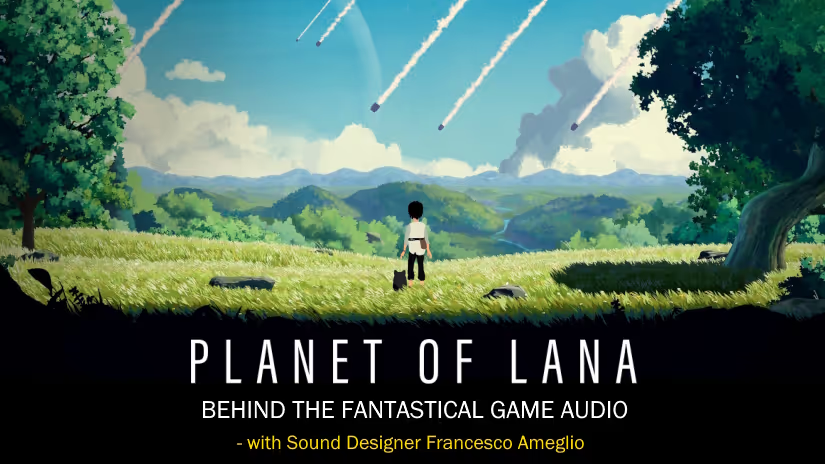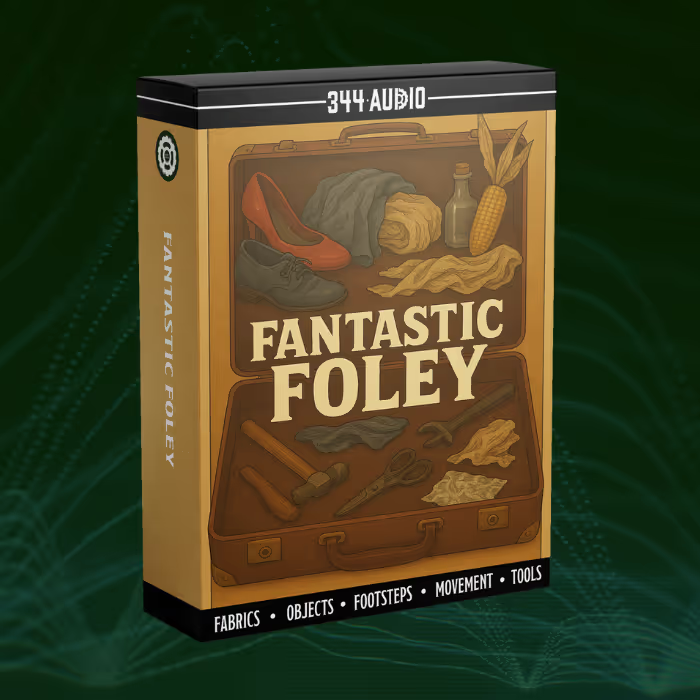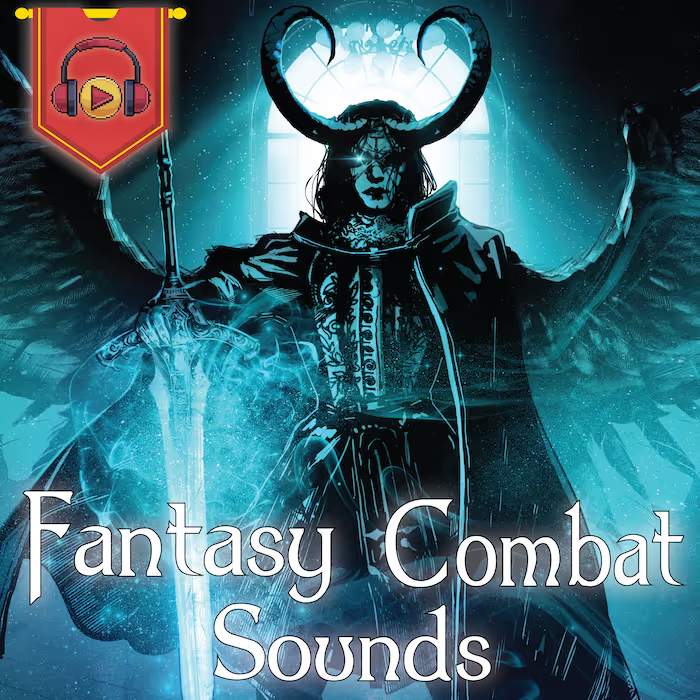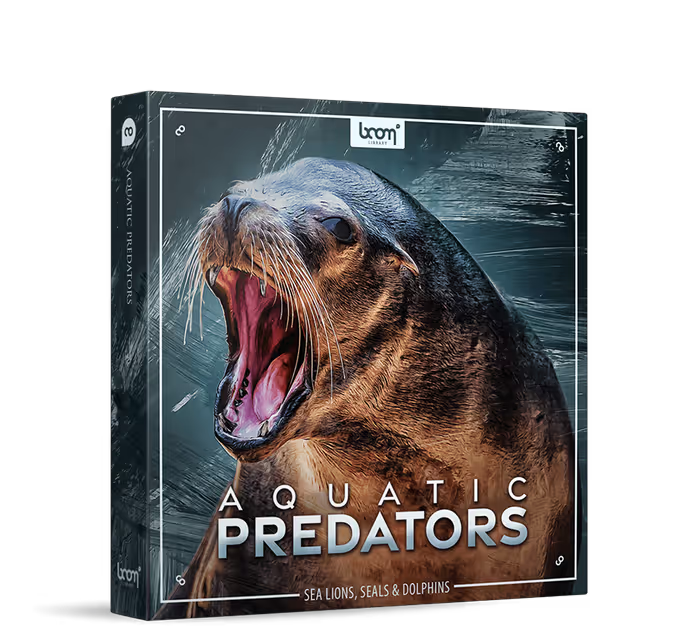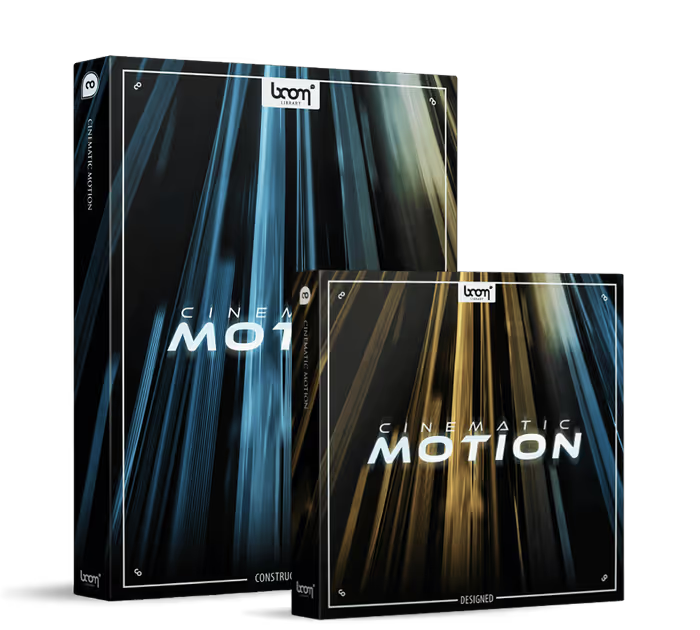When there’s a scary alien invasion of one’s planet, having a cute kitty sidekick makes it more bearable. In Wishfully Studios’ new puzzle-platform game Planet of Lana, the player takes on the role of a young girl named Lana who survives an alien invasion of her planet. The first thing that Lana saves is a black cat named Mui. Not only does Mui play a role in solving the puzzles, it provides some wonderful opportunities to de-stress. In the game, Lana can kneel down and pet the cat. Hearing its delightful purrs is a nice break from facing deadly robots waiting to zap you to death. Mui’s sounds were performed by Planet of Lana sound designer Francesco Ameglio.
Ameglio started work on the game in pre-production, helping the team at Wishfully Studios to craft a unique sound for Planet Novo by building rich and dynamic ambiences that get more complex the longer the player stands still.
Ameglio also brought in two other sound designers — Andrea Bo and Marco Furlanetto — who were integral to the sound team later on in the production cycle. The trio runs Settete, an audio collective of sound designers and composers based in Torino, with experience in game audio, movies, television, sound art, and sonic branding.
Here, Ameglio talks about designing a custom ambience system for ‘listening to the world,’ creating distinct ambiences for different biomes, performing vocal sounds for Mui the cat, creating robot sounds that fuse organic and high-tech elements, designing the flying robot sounds, crafting musical/tonal puzzles that players can figure out, designing massive musical sound design for the light beam puzzle, and so much more!
Planet of Lana | Launch Trailer
The world of Planet of Lana is amazing to listen to. There are so many interesting spaces! Before the alien invasion, the ambience is lush and peaceful, with pretty birds and gentle winds. As you get further into the world, there are these great digital and synthetic elements incorporated into the ambiences, like little digital purrs or strange bird calls. Can you talk about the sounds you created for the ambiences? For the forest/outdoor sequences? For the underground caverns? For the watery caverns? For the desert-like areas? For inside the alien spaceship?
Francesco Ameglio (FA): Thank you so much for your kind words. We spent a lot of time working on the island since we knew that the environment is where the storytelling is taking place; it’s this made-up planet called Novo.
Every biome had to have a specific character and specific behavior in terms of sound.
From the get-go, we knew it was extremely important that the ambiences sounded almost alive, like a character somehow. We spent a lot of time sketching and concepting the ambiences. It might have been the first thing we started on during the concept, so we knew we wanted to have different biomes, like the village, the invasion, the shipwreck, the alien base, etc. Every biome had to have a specific character and specific behavior in terms of sound.
We didn’t record too much ambience. We had some recordings in the forest, but I would say most of the sound was sourced.
Before we started sketching at the beginning, I was talking a lot with the game’s writer and co-director Klas Martin Eriksson. One of the main concepts we talked about was having contrast in the ambience. Contrast was a keyword when doing the sound design. We knew that planet Novo looks like Earth, but it’s not Earth. So in the forest, instead of the usual birds you’d expect to hear, we’d have exotic birds. Or, there are animals that you’ll never see but they’re there.
We were able to create sounds for species that you’ll never see, but that live on the planet.
Sound has this huge power. The strength of sound is that it can go beyond the screen. We were able to create sounds for species that you’ll never see, but that live on the planet. For instance, we have all these weird birds. I came up with the idea of taking exotic bird sounds and processing them with granular synthesis, and spectral morphing so it sounds like new birds, new species. They are a mix of robotic and organic elements and real birds.
We placed these animals/creatures in the world to make it feel alive and, at the same time, unique. So each biome has its own birds or creatures. It might not be birds necessarily. But it plays into this idea of having contrast through the biomes and in each biome, you hear something different.
Basically, if the player stays still (doesn’t move at all), they’ll start to hear new sounds being introduced into the ambience.
Another important thing for me – which I talk about on the Steam blog – is that since the music is mostly on the cinematics and not so much on the gameplay part, the ambiences play more prominently in the mix. And since the player has to solve a lot of puzzles in the game, I feel like they would spend a lot of time just thinking about how to get from A to B, and so maybe the player will stay still for a while, just thinking. So I came up with this idea of this system that we call ‘listening to the world.’ Basically, if the player stays still (doesn’t move at all), they’ll start to hear new sounds being introduced into the ambience. This is similar to what would happen in the real world – if you stand still in a forest then you start to hear new sounds. Maybe you hear them starting in the distance.
Each biome has its own system for ‘listening to the world.’
I don’t know if anyone has noticed (maybe no one will notice) but that’s the beauty of the game. So after a certain amount of seconds, the ambiences will become richer and richer. You’ll start hearing more birds, and you’ll start hearing elements of the story. For example, after the invasion, when you are in the grasslands in the countryside, you will actually start hearing the explosions from far away because you’re still running away from the invasion at that point. So, you start hearing distant explosions and rumble, and that’s part of this story actually.
Each biome has its own system for ‘listening to the world.’ So if you’re in the shipwreck and you stay still, you start hearing metal creaking or things falling or pretty frightening creatures in the distance.
When you start moving again, these sounds will disappear. So that was how we could make the ambiences richer and more interactive and dynamic.
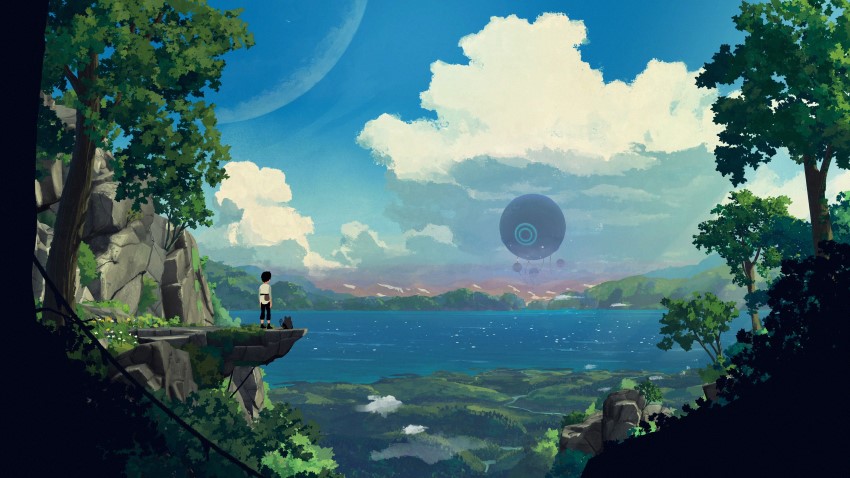
It’s so great that you had the forethought to build a whole system for ‘listening to the world’ that mimics real nature on Earth. So, when you stand still, all the animals and birds and bugs become more comfortable with your presence…
FA: I’m not sure if anyone will notice. You put it in there and hope someone will get it. But if not, that’s fine. We had fun doing it.
So, for example, if you’re in the forest or the grasslands of Chapter Four, and you stand still, you start hearing flies buzzing around in a very close perspective. Because in real life, if you’re standing still, flies will come at you and maybe bite you, or mosquitoes. As soon as you start walking again, those things will disappear.
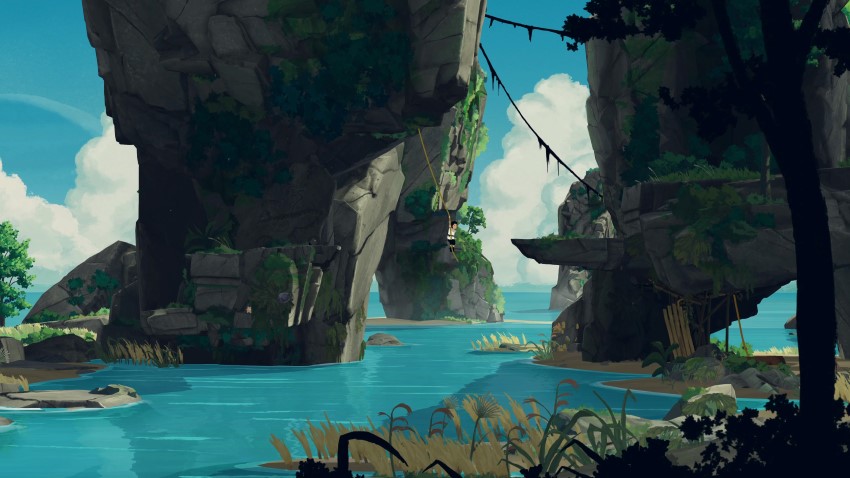
Any specific sounds or tones that you created for those different biomes that you wanted to talk about?
FA: As I mentioned, each biome has its own characteristics and its own spectrum of frequencies. Some biomes are more natural. For instance, when you are in the forest, it’s more like an actual forest even though you hear these weird animals.
…we wanted to give a better sense that you are indoors. So, in the shipwreck or in the alien base, it’s more tonal.
For other biomes, like the shipwreck, we wanted to give a better sense that you are indoors. So, in the shipwreck or in the alien base, it’s more tonal. So you have this contrast of being outside where it sounds more open and vast. And when you go inside, it sounds more like a music track, I would say. It sounds very ‘internal’ to me when you’re inside, especially in the cave and the shipwreck.
…I created this massively distorted bass sound. It gives you this feeling of ‘what’s going on here?’
Near the end of the game, for inside the alien ship, the creative director wanted to make this place extremely unique and very out of place. You spend the whole game getting there and so it should be a very uncomfortable place. It should be something you never heard before. It’s a bit like the movie Arrival – these aliens have come from very far away and so it should be something you have never seen or heard before inside their ship. So, when you first get into the ship, you hear the sound of babies laughing. And then in the next room (just after the babies), I created this massively distorted bass sound. It gives you this feeling of ‘what’s going on here?’
It’s a big contrast to what came before.
Then you end up in this huge room where the humans are in prisons. We had this joke that it should sound like a spa (as if you’re in a spa for robots). So, again, we have this contrast of going from a massive distorted sound that’s very disturbing to a very quiet spa for robots. But it’s still weird because it’s not a spa for humans (they’re locked in their cells). It’s for robots.
So when we defined the vision, I would say one of the keywords was contrast.
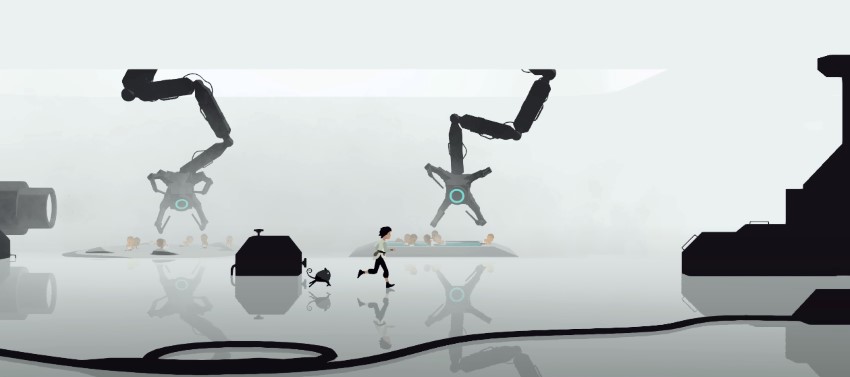
That was really surprising when you get onto the alien ship and hear babies laughing! I loved the foley for Lana’s footsteps there. You can hear that she’s walking on a metal floor, and she slides down a metal beam and it sounds like squeaky metal…
FA: Foley was one element that we could keep as extremely realistic. The ambience is totally out of place, but your movement is still very real. This game is about contrast, and about making things feel out of place.
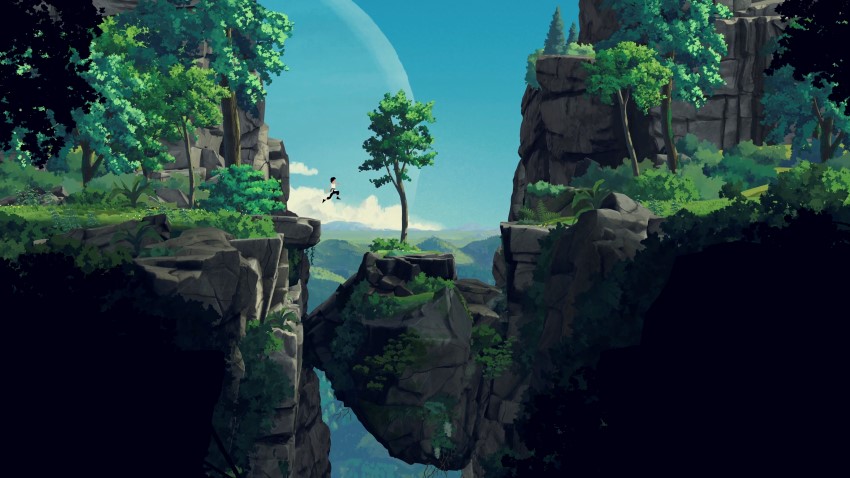
What went into the foley? Did you perform that or did you work with a foley team?
FA: We performed the foley. We recorded a lot of footsteps, and a lot of foley sounds internally. We didn’t outsource it. We actually built this small pit and we did it in my studio. It was fun making all these surfaces.
For the jumping in-game, there’s a system that detects the height of the jump. So if it’s a very high jump or a jump from something that’s high up, it’s going to sound different. There are a lot of small details that make the foley very interactive and dynamic in terms of what’s happening on-screen.
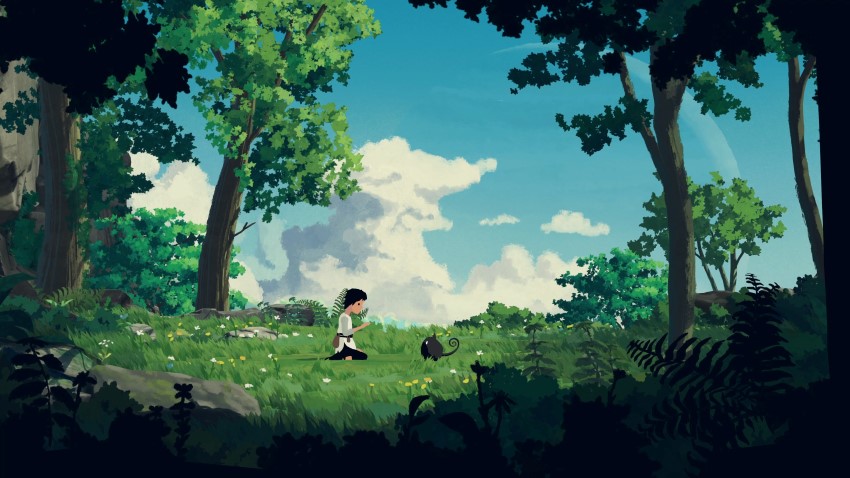
I love the sounds of the cat, Mui. Who performed those sounds?
FA: That’s me! We thought Mui was going to be very hard to create because the whole game is based on the relationship between Lana and Mui. Mui speaks its own language and Lana speaks her language, so Lana doesn’t really understand what Mui is saying. This is a huge part of the game so we thought it was going to be super tough to get right, but actually, it wasn’t.
I recorded myself doing very weird sounds. I tried to sound as cute as possible.
I sketched out some sounds and performed them. I recorded myself doing very weird sounds. I tried to sound as cute as possible.
It was fairly simple in terms of processing. I did some pitch shifting, and a bit of morphing with another creature I think was a cat. And then I integrated and the creative director and the writer just loved it. So we got it on the first try. It was fun. Mui is basically me doing weird sounds in my room.
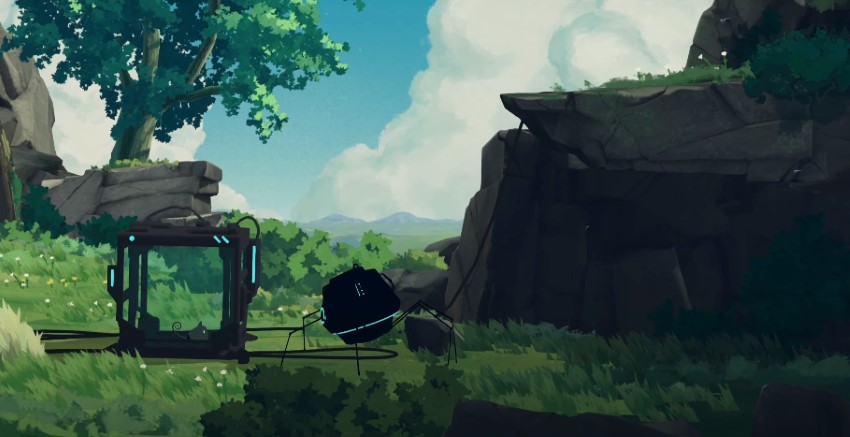
There are some places where Mui’s vocals are treated – for instance, when Mui is captured inside the glass containment boxes. What went into that?
FA: That processing was done in real-time in the audio engine because those details came a bit later. So, we recorded a lot of samples for Mui and then we put them into the game, and the audio engine handles the processing for those moments.
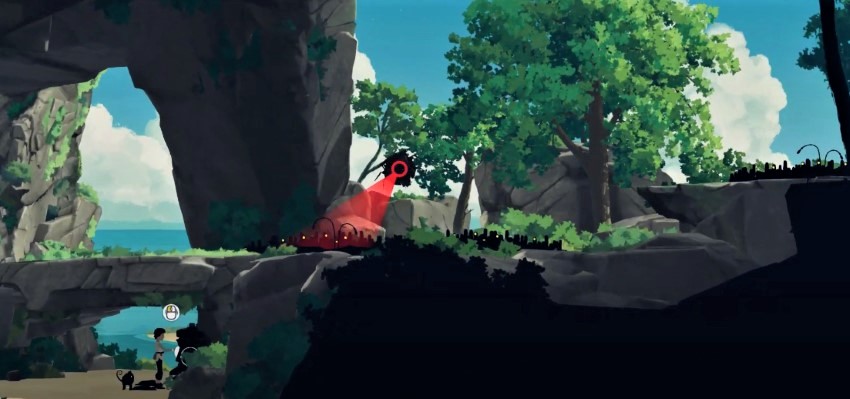
What went into the sounds of the robot aliens? There are flying robots and at one point Lana gets to control it. What a great flying sound! How did you create that?
FA: That was the opposite of Mui; that took a lot of iterations. We had a first draft early on in the development and that sketch stayed for a long time. It sounded very different from what it is right now. It was way more noisy. There were a lot of things going on. For instance, the flying system was very complicated and it was too noisy.
…the game gets bigger and more things are happening and the original sound was too much.
We realized that when we started adding more flying robots to a sequence – two or three flying robots at a time – that the sounds didn’t work. It worked for a situation with one flying robot, but (as often happens) the game gets bigger and more things are happening and the original sound was too much. So we had to iterate a few times, and the sound became more minimalistic in a way. Initially, we had a lot of layers for the flying sound and we just got rid of 80% of them and that’s how it became what it is now.
It was hard because we wanted to have this frightening sound when the player sees the flying robots for the first time. But then at a certain point, as you said, the player can control it. So it had to change, to become a bit more cute in a way. So it has two personalities because when the player can control it, it becomes a ‘good’ robot.
The sound is based on synthesizers, not real source sounds.
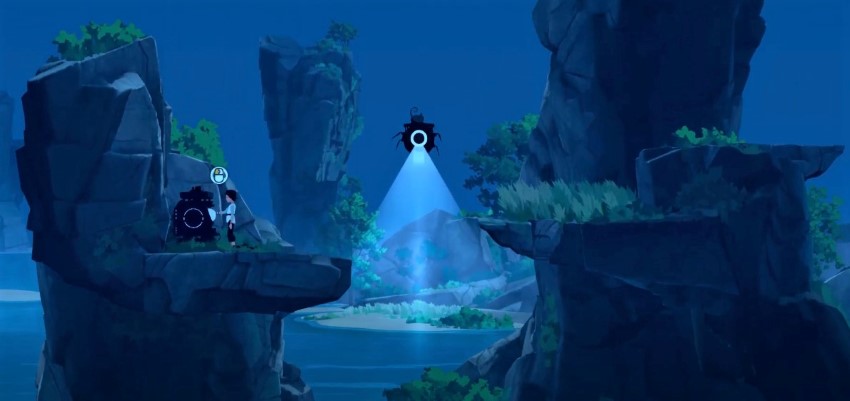
Can you talk about your approach to changing the sound in-game to match the player’s control of the flying robot? How did you handle that?
FA: We wanted to make it feel alive, so for the flying system, there are several processes that are controlled in real-time. There is one parameter that controls the speed and the angular speed, so if the robot is flying in a curve, we are receiving all this data from the game engine, and that’s altering the pitch, the distance of the sound, and it also adds in a few sounds on top of the normal layer for sudden changes in speed or direction. Or, if you smash into the rock walls or the ground, those sounds are added in. And that’s all happening in real-time in the game in the audio engine.
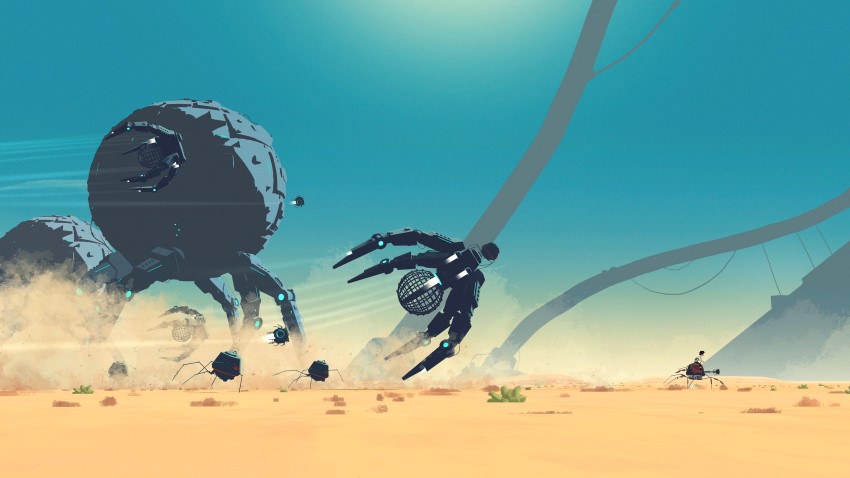
There are other robot aliens in the game – aside from the flying one. Can you talk about your designs for those?
FA: All the robots were a huge part of the game. We spent a lot of time creating the sounds for the robots, trying to identify what the palette would be for the robots.
He imagined the robots to be insects in a way, but they have to be extremely precise, almost like they’re designed with high-tech engineering.
There’s a robot that looks like a spider and we call it the scout robot. That was the first one we integrated into the game. Klas, the writer, said something very interesting. He imagined the robots to be insects in a way, but they have to be extremely precise, almost like they’re designed with high-tech engineering. So they have to be both organic, like an insect, yet super precise.
And again, going back to the idea of contrast, they had to sound very distorted because there’s something weird happening in their body. They’re more than just bad guys. (It’s part of the story which you find out when you reach the end of the game).
So I thought, ‘Why don’t we add this distortion on top to make them threatening and menacing but at the same time, a bit more obscure or mysterious?’
I put all of these sounds put into the Palindrome plugin and just messed around with the settings, with the morphing.
We did a lot of iterations on the robots and their sound is made up of a lot of insects like bees, flies, and mosquitoes with processing from this cool plugin called Palindrome from Glitchmachines. It allows you to morph four sounds at the same time. So in addition to insect sounds, I added in cameras zooming and servo motors, and a letterpress machine from the ’40s and ’50s that I recorded. It was a machine used to print books. They’re simple but they have a very mechanical, precise sound almost like a weapon somehow.
So I put all of these sounds put into the Palindrome plugin and just messed around with the settings, with the morphing.
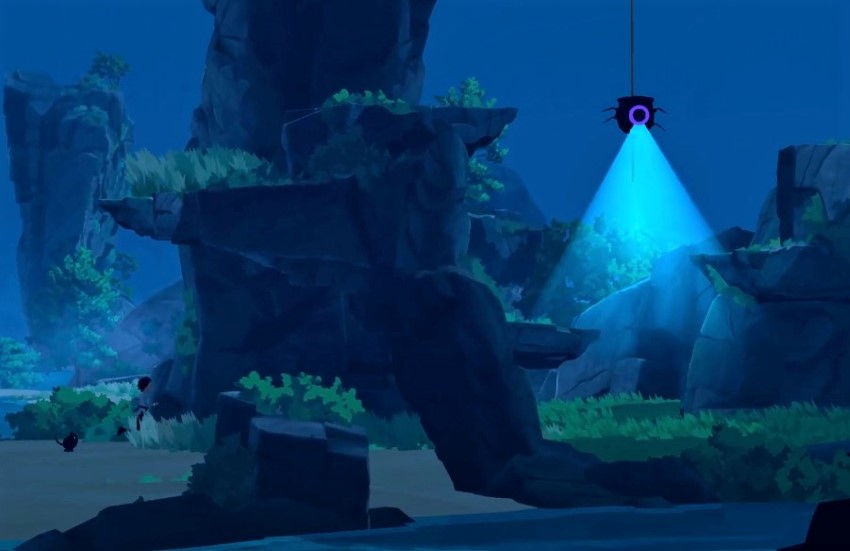
The scout robots have this flashing color pattern, and the sound of that is musical/tonal. Was that something you created or was that coming from the composer?
FA: As Klas was writing the plot, he had this idea of using melodies. So even before hiring the composer, there was this idea of using music as well as language. So in the game, you have many sublevels of language. You have the made-up language for Lana, her sister, and the villagers. Then you have Mui’s language, and then you have the robot’s language of how they communicate with each other.
There’s also this part of the music language, which is the melody. And so you have a ‘good’ and a ‘bad’ melody.
There’s also this part of the music language, which is the melody. And so you have a ‘good’ and a ‘bad’ melody. There’s a robot base in space that is communicating with the robots on the planet, and they’re making these melodies using certain notes. That idea came from Klas in his script.
We started to experiment and that was a lot of work. We iterated so many times. We experimented with tonal sounds but weren’t sure if it should be sound design or something purely musical. That was a very tough sound to get. I created a lot of options but Klas had a very unique clear idea of what he wanted. We ended up using some of the piano sounds that he recorded, some notes, and then I processed those sounds to make it more distorted like it was coming from a robot. It ended up being a combination of sound design and Klas making sounds.
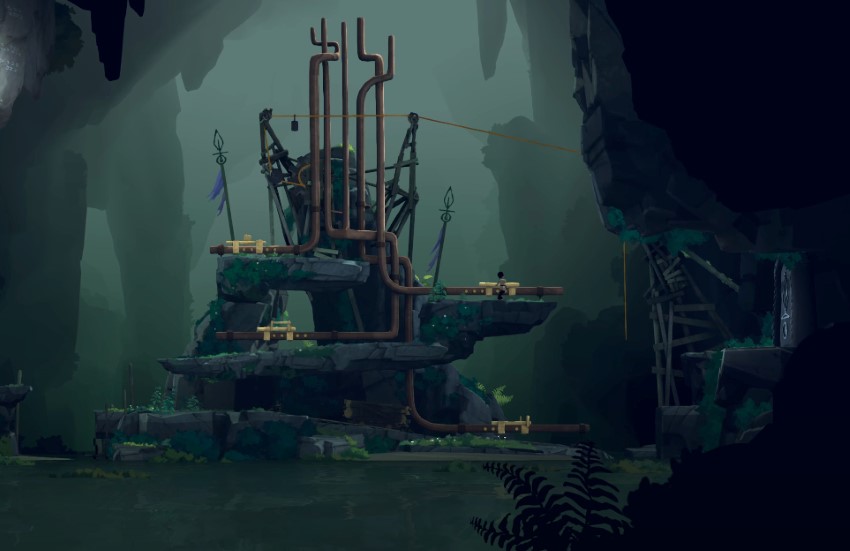
There are several fun sequences that use musical sound design – like the toned pipes puzzle in the cavern, and the giant ball of light on the alien ship, which Lana has to neutralize with the light beam. Can you talk about your work on those?
FA: Andrea, the other sound designer, took care of the musical puzzle in the cavern. (Andrea Bo and Marco Furlanetto were the other two sound designers I worked with; they helped me a lot during the final year and a half of production.)
…we had the tonal part hidden in the sound and we found from our QA testing that it was very hard for players to understand where the pitch was, and if there was any pitch.
It’s always hard when working on a music puzzle. You have to be aware that the players might not have musical training or knowledge. We work with music, we work with sound, so we have more trained hearing, but I guess 99% of people don’t, which is totally fine. So at first, we had the tonal part hidden in the sound and we found from our QA testing that it was very hard for players to understand where the pitch was, and if there was any pitch. It was more like pure sound design mixed with the notes.
Part of the process of creating that puzzle was reducing the noisy part of the sound, reducing the sound design to have just the note being played. We ended up with this huge pipe organ resonating in this cave.
I can’t remember exactly but I think all the reverb is done in FMOD in the audio engine. It was quite huge; it was demanding a lot of resources. But I think it worked really well.
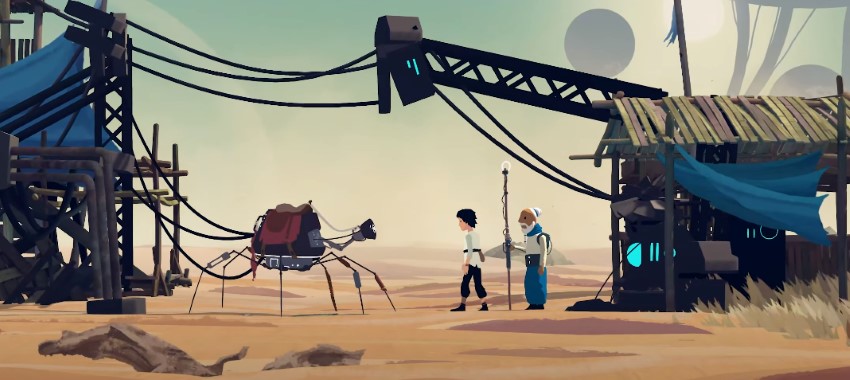
There was another music puzzle when you meet the old man in the desert. We had the same issue there, so we had to be aware of the musical properties of the puzzle. We couldn’t go full sound design. We had to stay tonal otherwise it would’ve been very hard for the players to understand the melody. Melody is such a huge thing in the game so it had to be extremely clear and in the foreground; it couldn’t be muffled with other sound design. You have to support the story in the game and the main mechanics and the plot. So we took a step back here and decided to leave it more tonal, which totally makes sense.
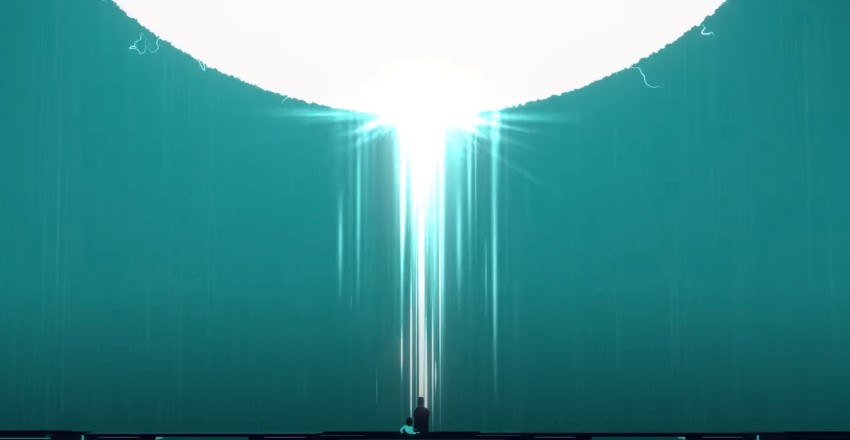
Later in the game, when Lana uses the light beam on the alien ship, that’s a good example of the sound design taking over. That scene is one of my favorites, and I have to admit that I didn’t do any sounds for that. That was mostly Andrea and Marco because that sequence came very late in development and I was involved in fixing things since we were about to ship. I was actually in Sweden at the time with the rest of the team. And so Andrea and Marco took care of that. They did a huge amount of work in a very small amount of time and they got it right. I really love it.
That’s an example of where we decided to go full sound design, to go big.
That’s an example of where we decided to go full sound design, to go big. It’s the end, so it’s the peak. The music is there, and it’s brilliant music, but we wanted to give a full sense of size to this huge orb. It’s full epic, full distortion. I believe that 90% of the beam sound was made with Xfer records’ Serum synthesizer. It’s just massively distorted. It’s all about distortion there, but it’s still pleasant in a way.
It’s interesting because for the beam Andrea used a choir of children in the sound. Earlier in the game, there was a moment where you hear a choir of children singing and that was recorded by Klas with a choir in a school in Australia. We used that recording for storytelling, and in the desert, so we decided to also use that beautiful singing for the beam when Lana and Mui are fighting against the orb. So, the choir is hidden in the layers of the beam. I thought it was a very nice idea.
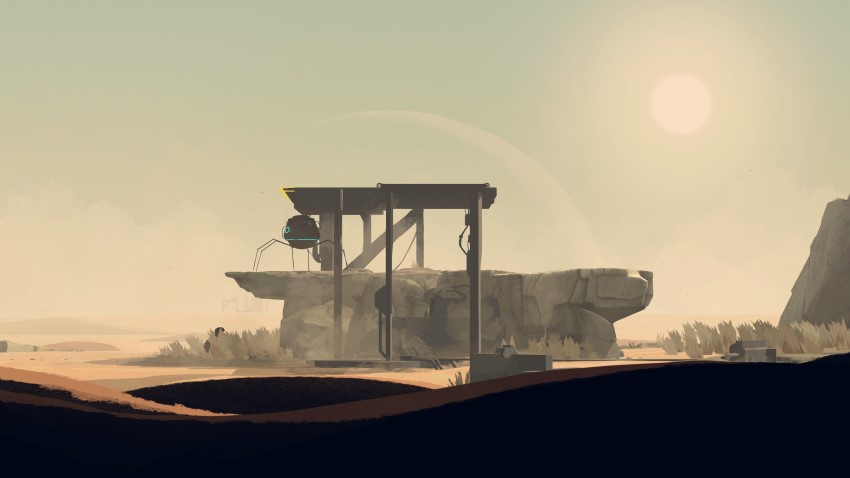
What were your biggest creative challenges on Planet of Lana? Was there a particular robot that took a long time, or another sound that you did a lot of exploration on?
FA: The robots took a long time, and so did finding the melodies. The melodies were a huge thing to define and get right.
…the system for ‘listening to the world’ basically meant that we had to design double the amount of ambiences for each biome.
One of the most difficult things to create was the BG’s because there are a lot of situations in the game where you are hearing just that. Marco spent months just sketching the ambiences. As I talked about earlier, the system for ‘listening to the world’ basically meant that we had to design double the amount of ambiences for each biome. So you’d have your normal layers of ambiences, and then when ‘listening to the world,’ we added more layers. It was double the work and pretty tough to get right because not all the levels were locked. The visual environmental artists were still working on that and did an amazing job, but sometimes we had to guess the environment. So we started just sketching ambiences without any visual context. So we’d get it back and do another pass and then another pass to make it feel cohesive with the whole game.
Some of the creatures in the background will make a sound when Lana gets close to them, and that is Andrea’s voice. He performed those sounds.
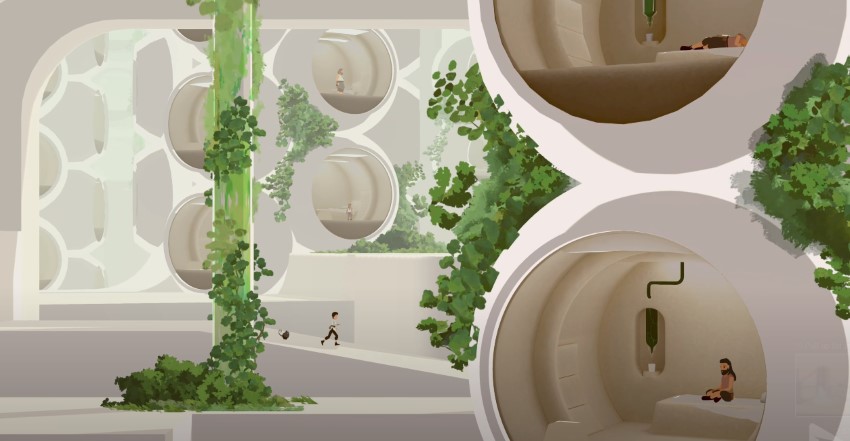
What were some of your biggest technical challenges on Planet of Lana? And were you involved with the implementation?
FA: Yes, we did all the implementation; it was done in FMOD in the audio engine.
Mattias Wargren was the lead programmer on the game, and he also took care of the audio implementation.
Mattias Wargren was the lead programmer on the game, and he also took care of the audio implementation. He helped a lot. He’s also very into music and sound design, so we’re pretty lucky. It’s not something that happens very often. He helped a lot with building the systems. He was very responsive. We came up with this huge system for ambiences and he made it. We were sending him crappy screenshots with things circled, saying, ‘It would be nice if we have something here.’ After a few hours, we’d have a system built for it. So we had all the system in place and we didn’t really struggle a lot with implementation. Mattias and the whole team of programmers were super supportive and they helped a lot.
He’s also very into music and sound design, so we’re pretty lucky.
As an audio team, we tend to set all the systems we need in the first part of production. It’s very important for us to have all the systems working for the first iteration so you don’t have any surprises towards the end.
Surprises always happen, but at least we are a bit in the safe zone where we have the systems we need and so we don’t have to bother coders, especially because at the end of the project they’re super busy.
So there were no big technical difficulties, I would say.
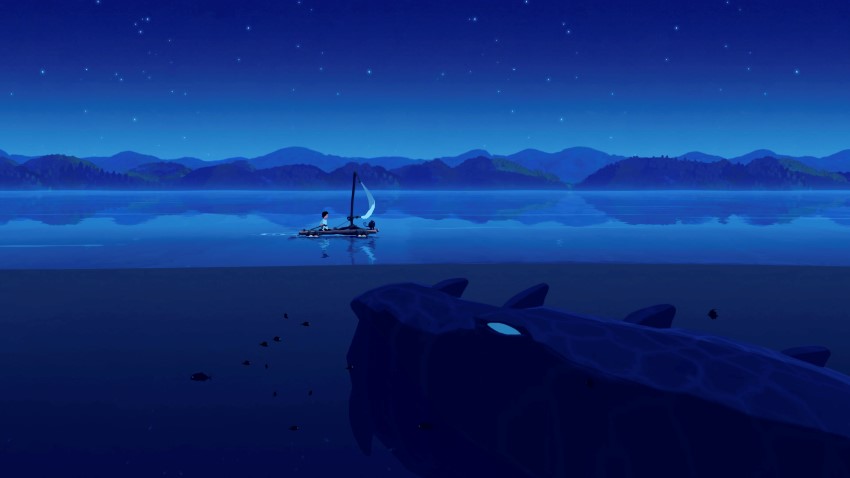
Is there a sequence in the game that you are most proud of and what went into your sound work there?
FA: I joined the project in a very early stage in 2019. So that was almost four years ago. We started working on Chapter Four, which was the demo. So we spent a lot of time working on the first few minutes of the game’s demo. That starts with Lana waking up and she meets Mui. That was one of the first things we worked on, so I’m very emotionally attached to it. So I would say that’s one sequence, for sure.
Shout out to Bianca, the actress who played Lana. She was 12-years-old when we recorded and that was her first experience in a video game as an actress.
I also really enjoy the alien base scene at the end where you go through the sound of babies laughing, and also the final fight. That’s quite intense. I really liked how Marco and Andrea came up with the sounds. It’s quite emotional.
Shout out to Bianca, the actress who played Lana. She was 12-years-old when we recorded and that was her first experience in a video game as an actress. But she was a really great actress. She had to act with this made-up language. It’s not that straightforward for an actress, especially if it’s your first experience, but she was really great.
When you work in video games, you have to act/perform the vocals without any visual context. It’s not like a movie. I showed her the demo, but it was in a very rough state. So it’s hard when you have to explain to an actor what is happening in the sequence, but they have to imagine what’s going on. So it’s tough. Even professional actors struggle sometimes, but she was great. She made it in her first try.
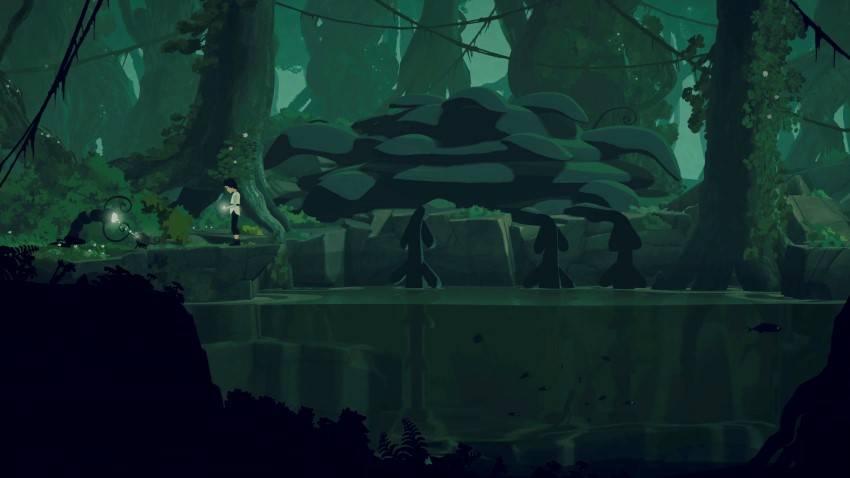
Is there a single sound that you’re most proud of?
FA: I really like what Marco did for these creatures (we call them large larvae) that you meet in the swamp. It’s like this gigantic larva that lives in a pond and you have to hypnotize it to control it so that it sucks the water out of the pond. The sound it makes is amazing. It has a very Studio Ghibli aesthetic and it’s just so fun. It sounds so alive, and it sounds so Ghibli. I’ve always been very fascinated by how that creature sounds. That’s probably one of my favorite sounds.
Also, at the end, I like what Andrea did for the fight against the orb. That is amazing.
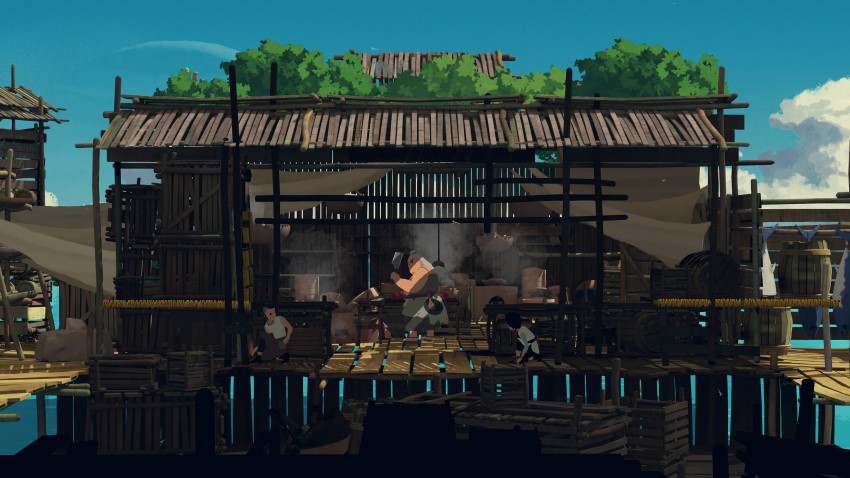
How has working on Planet of Lana helped you to grow as a sound designer? What have you learned while working on this game?
FA: As I said, it was a very long process (almost four years) and I was very lucky that when I joined the team they were in the very early stage, so they were concepting. It’s not that common that as a sound designer, you join the team in that moment of pre-production. That was extremely helpful to get the vision right. Not only the artistic vision but the music vision and the audio vision.
It’s not that common that as a sound designer, you join the team in that moment of pre-production.
Also, the team was extremely supportive. Klas (the writer and co-director) and Adam, the creative director, were very into sound. They paid a lot of attention to the details in the sound. And that’s very uncommon. It’s been great to work from the very early stage, and Andrea and Marco helped me a lot in the last year and a half. So that was amazing.
On Planet of Lana, I learned how important pre-production is for defining your vision as a sound designer. That is extremely important, and it makes such a huge difference through the process, through the production, because sometimes, especially with these long projects, you end up losing a bit of focus. You start with an idea, and then after a couple of years, it gets lost. But I think that’s normal. There are so many things happening, so it’s just a matter of finding your lighthouse and going back to it. That’s why defining the vision at the beginning of the project is extremely important. So that was a very interesting and unusual experience.
…I learned how important pre-production is for defining your vision as a sound designer.
Andrea, Marco, and I run an audio collective called Settete. We provide audio design for video games and this was our big project together. It’s very important for us to share this vision together.
A big shout out to the composer Takeshi Furukawa. He did an amazing job of crafting the music for the world, for the cinematics, for everything. He came up with the idea of having ‘good’ and ‘bad’ melodies that you can use throughout the game to solve puzzles.
A big thanks to Francesco Ameglio for giving us a behind-the-scenes look at the sound of Planet of Lana and to Jennifer Walden for the interview!

